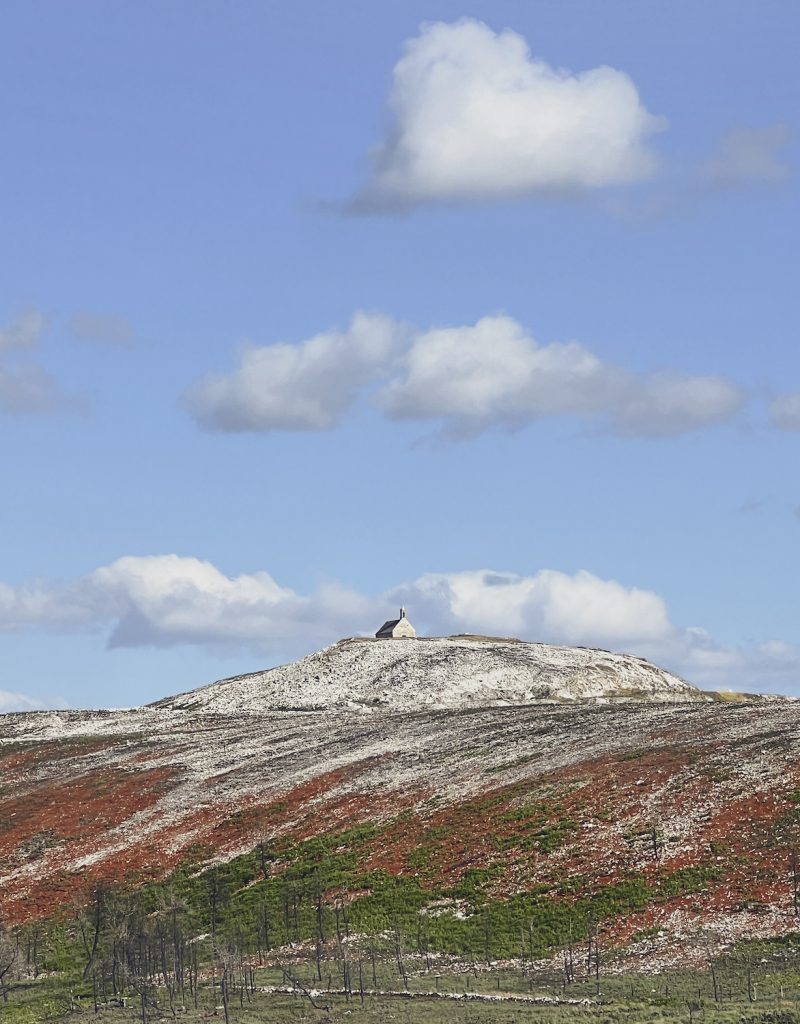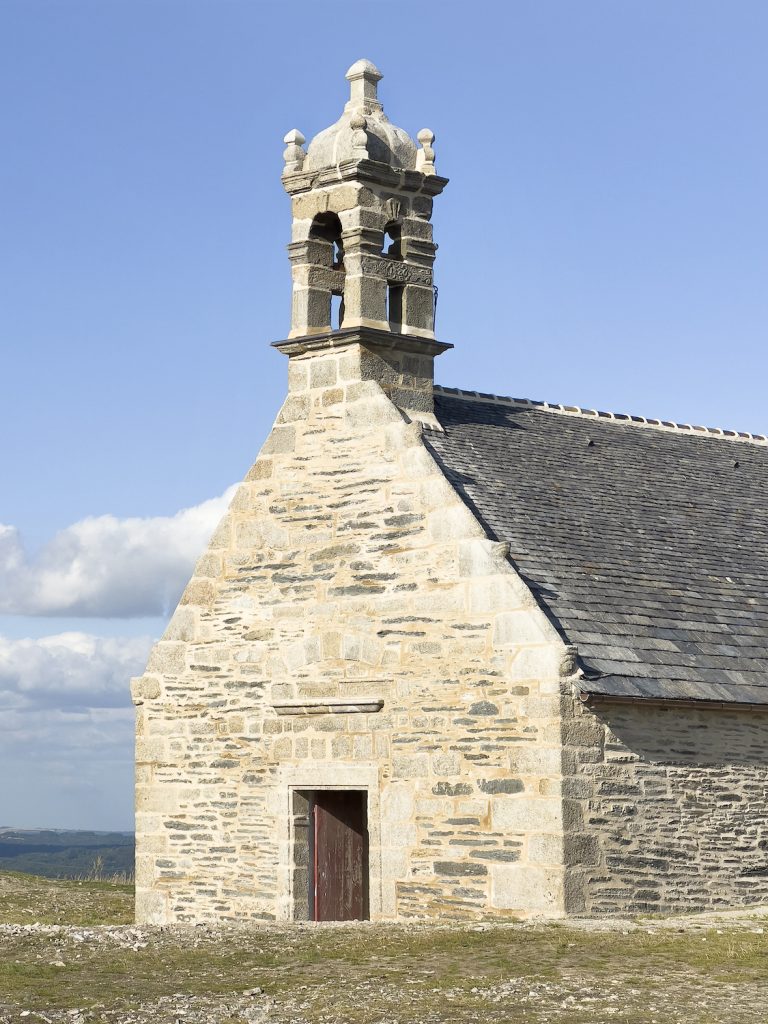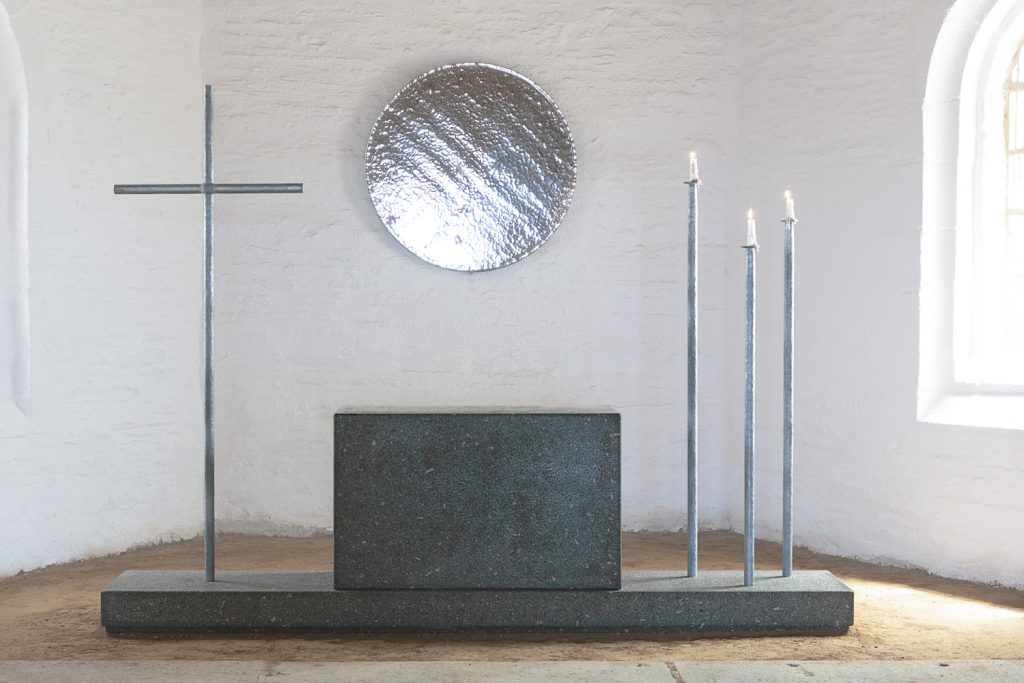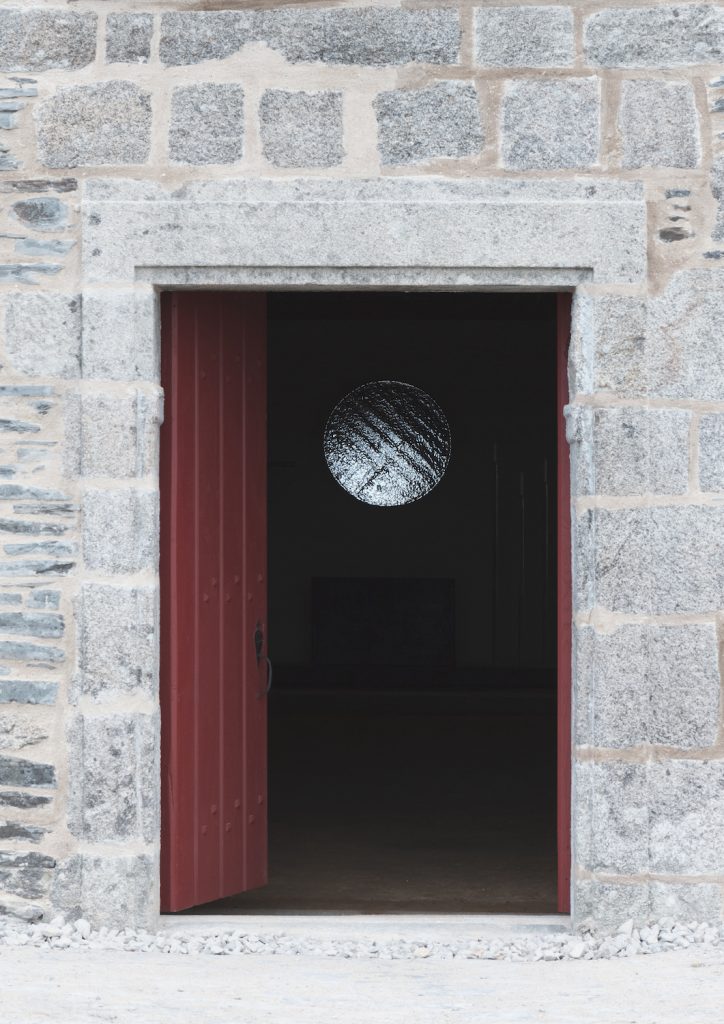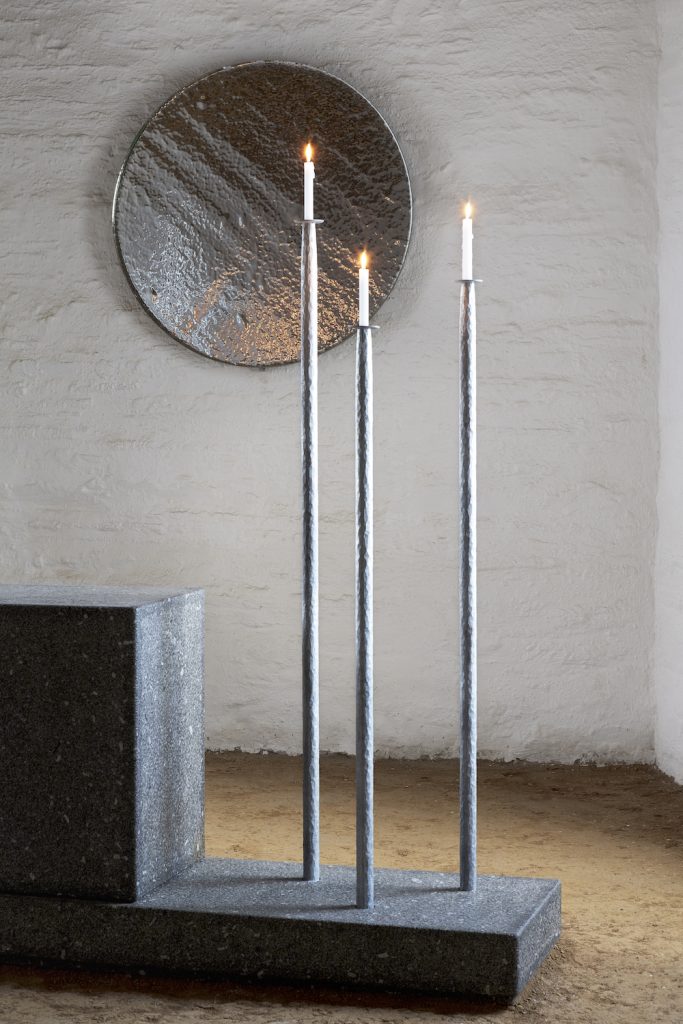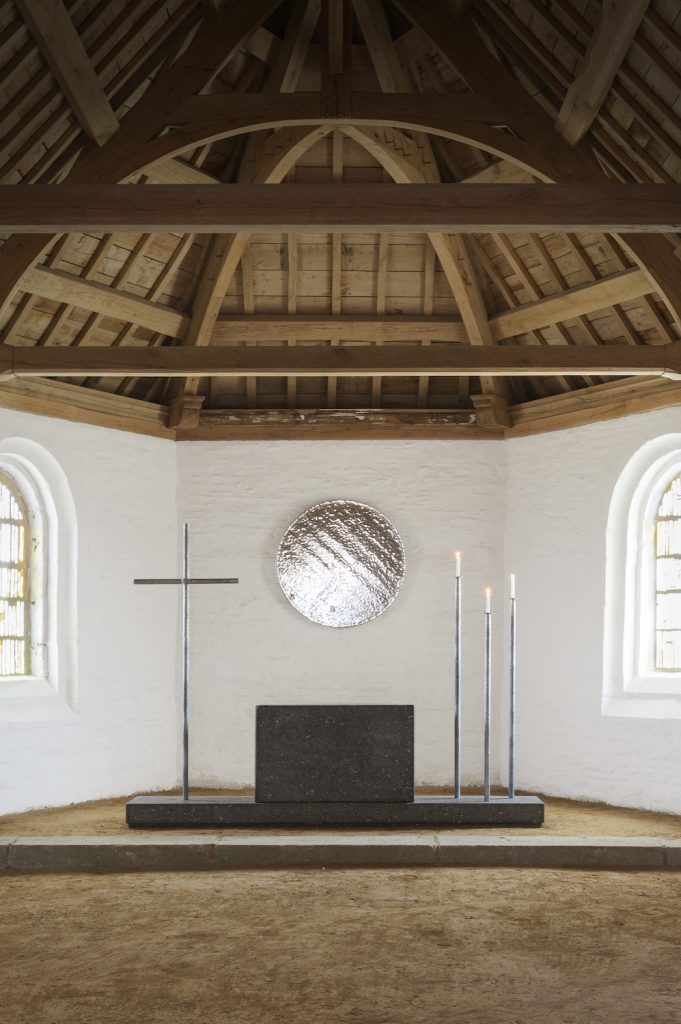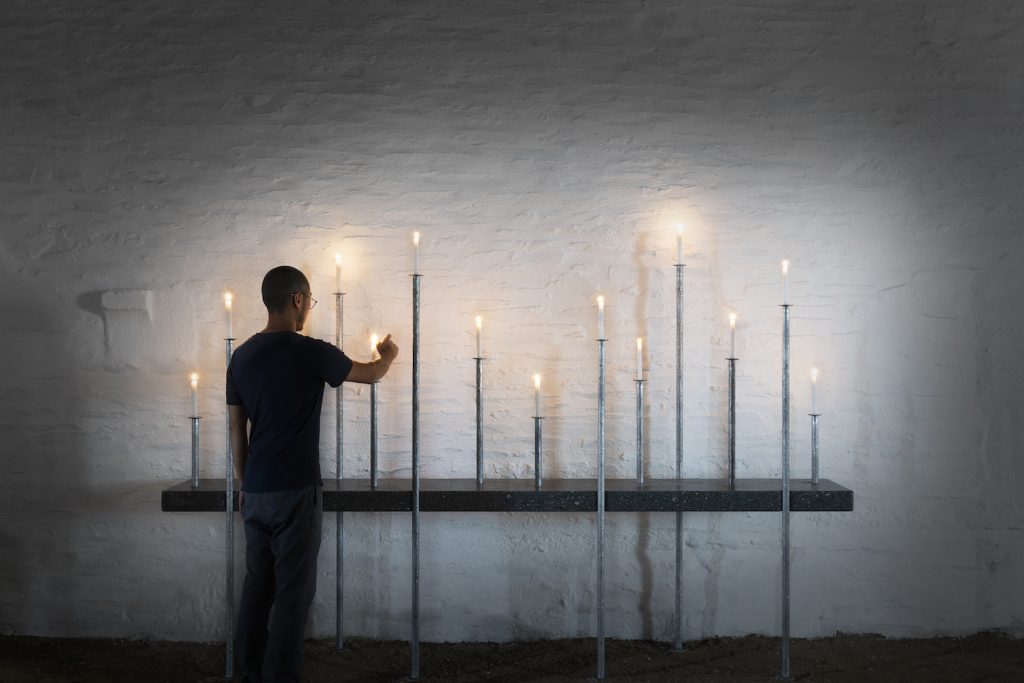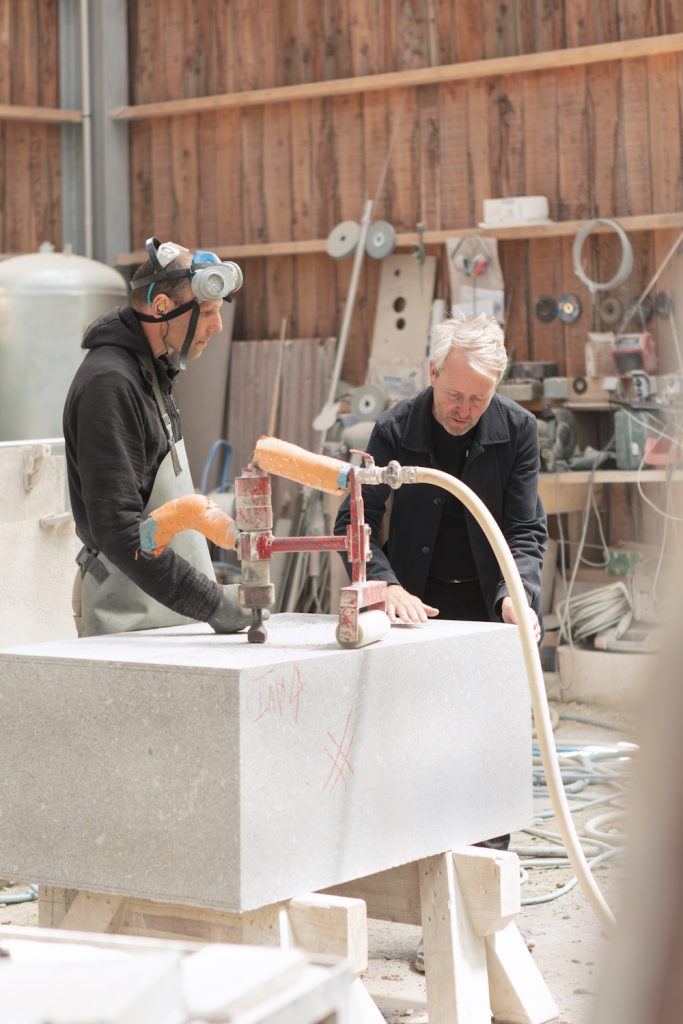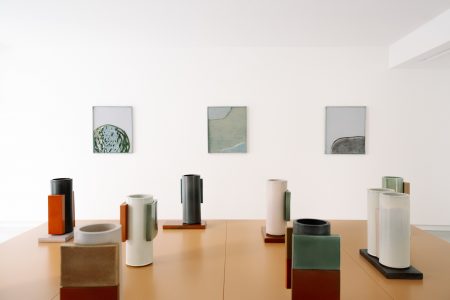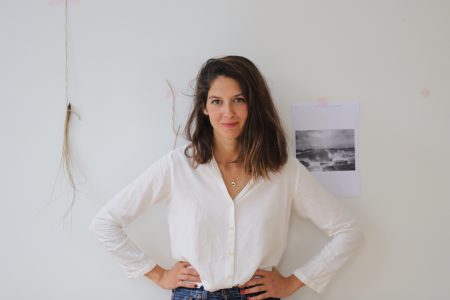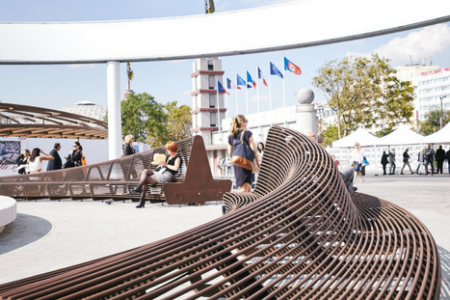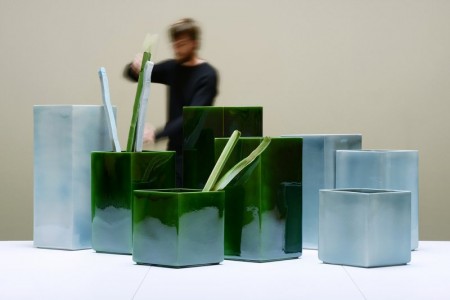Ronan Bouroullec: La Chapelle Saint-Michel de Brasparts
Martin Bethenod, Managing Director for the Bourse de Commerce – Museum of the Pinault Collection, wrote an essay for the launch of Ronan Bouroullec’s collection of furnishings for the tiny chapel of Mont Saint-Michel de Brasparts in Brittany.
Mont Saint-Michel de Brasparts did not escape the wild fires that engulfed Brittany’s Arrée hills in July 2022, but the fires did not reach the chapel on its 381m summit. Built at the end of the 17th century, in line with an ancient religious tradition on the site, it has now undergone a complete restoration, with a set of new furnishings designed by Ronan Bouroullec.
The Chapel of Saint-Michel de Brasparts is a modest building, rectangular in plan, with a canted apse. The walls are over a metre thick. The Arrée hills slate roof rests on an oak frame, magnificently restored by the craftspeople from Ateliers Le Ber in Sizun. The beaten-earth floor is slightly raised in the choir area. The stone walls are lime-rendered. The door of the main west facade is only rarely used. The south door is always open, it has no key, providing refuge, a resting place open to all – passers-by, hikers, pilgrims.
Other than a stone font and a few improvised makeshift items – votive offerings, homemade wooden crosses, pebbles, dried flowers – the chapel stands empty. There is neither lighting nor electricity. Light comes in through the two windows of the apse – glass slabs in the abstract style popular in the 1950s and ‘60s, influenced by the magazine L’Art Sacré. The contrast between its simple starkness and the beauty of the landscape it overlooks – with all the force of the wind and rain from which it protects visitors – and the spiritual energy it exudes, produces a powerful effect.
The Chapel of Saint-Michel de Brasparts plays a variety of roles in Ronan Bouroullec’s memories. As a landmark on the road that crossed Brittany from his home in the south, to that of his grandparents in the north – a mysterious beacon in the distance, glimpsed from the car on each visit. The memory of wildfires that had already affected the region in the 1970s, and the powerful image of the blackened landscape, against which the paler form of the chapel stood out in contrast. And another kind of memory, the involuntary memory that since Proust’s In Seach of Lost Time, we know to form an essential element of the human experience, rooted in an impression that is tactile, auditive, olfactory. This aspect of physical sensation – the half-light, the damp, the feel of the stone, the relationship of one’s own body to the massing and the familiar spaces – is the source of his project for Saint-Michel de Brasparts.
More broadly, it is also key throughout his entire creative process. By fundamentally integrating intuition, daydreaming and synesthesia, the process is less about providing a specific response to a direct question, executing a predetermined functional, iconographic or symbolic brief, than about creating an experience – according to John Dewey’s interpretation, a full encounter with an external phenomenon, which follows a complete course from beginning to end, and which is integrated in the conscience as an entity distinct from other experiences.
To design an object, a space, an exhibition, is an attempt to produce, on the basis of a few selected and inter-related elements, an effect that goes beyond the materials, the objects and the place itself, to elicit in the viewer or user a particular state, the feeling that something is happening and that one is being changed by it.
The chapel provides the ideal context for this process. By provoking a temporary suspension of the movement and sound of the world around, its role as a place of worship and reflection generates very particular qualities of silence, concentration and contemplation, of attention to the world and to oneself. Qualities that in Saint-Michel de Brasparts are further intensified by the sense of elevation from climbing the hill, from the relationship with the sky and the landscape.
Ronan Bouroullec’s project is based on a three-pronged approach: finding a vocabulary of materials that is reduced to the bare essential; finding a balance between a sense of mass and of lightness; finding the vibration in things through the treatment of surfaces and light.
Materials
The feeling of a powerful continuity between the Chapel of Saint-Michel and its site, between architecture and nature, is one of the first impressions that strikes the visitor. The materials used for the elements added by Ronan Bouroullec extend this continuity, as if derived from the surroundings. First a granite, Nuit Celtique de Huelgoat, a dark stone studded with shards of white, like the starry night sky over the chapel, virtually devoid of light pollution. An impressive block of it was quarried in Brennilis, less than 15km away as the crow flies, and then cut into three pieces, worked by stone mason Christophe Chini from Plonévez-du-Faou: a horizontal base, the alter above it, and a console-table for candles and objects placed by visitors.
While Ronan Bouroullec does not often use granite – the closest is probably the basalt version of the Piani lamp (Flos, 2011) – forged and hammered steel is, however, a recurrent material in his work, resulting in a fruitful collaboration since 2015 with Italian manufacturer Magis on the Officina range, which includes a series of candelabras. But unlike these, the elements for the Chapel of Saint-Michel have been hand-crafted, by Mathieu Cabioch, artist–metalworker based in Roscoff.
The third element, glass, also occupies an important place in Ronan Bouroullec’s work: from the first mirror, made in 2003 for kreo, and subsequently through numerous collaborations, both artisanal and industrial, notably with GlasItalia and Ittala, to the Flou collection of mirrors launched in 2021 at the Pinault Collection–Bourse de Commerce. The link between the glasswork and Saint-Michel de Braspart is not geographic (it was made by glassmakers from the Venice region, with whom Ronan Bouroullec has been working since 2018), but is part of a dialogue with the only existing decorative element in the chapel – its stained-glass windows, attributed to the Breton master glassmaker Auguste Labouret, who also made those of many churches in Finistère, notably in Morlaix, Roscoff and Brest.
Balance
Heavy enough not to be moved, sturdy enough not to be damaged, rough enough not to require cleaning, the elements that Ronan Bouroullec has placed in the Chapel must succeed, despite or because of these characteristics, in creating a sensory experience, in establishing an intimate relationship with the Sacred.
The whole challenge of the project lies in the magical operation of creating lightness from mass. To achieve this, the notion of balance was key. Balance in the proportions, applying the rules of the golden ratio to the alter. Balance in the paradoxical relationship between the mass of the block of granite for the console-table, and its virtual suspension on steel legs that extend into candlesticks. Balance between the weight of the mirror and its impalpable, almost unreal quality.
And balance is also at the heart of the reflection on connections between the different elements – the question of connection being central to Ronan Bouroullec, to the extent that it defines much of his work. The stone elements are simply assembled, resting one on the other, with a very slight overhang on the base that gives the impression of just lifting off the ground. The forged pieces are simply embedded in the blocks of granite or the earth floor. The two pieces of the cross are assembled using the simplest connection possible, a bar with a rounded hole.
Vibration
Equally vital is the notion of vibration, which at the Chapel of Saint-Michel de Brasparts is achieved through forms – no line is straight, no edge is square, all have a slight curve, sculpted by chisel – and above all the surfaces, of each material in order to reinforce an effect of continuity of texture between them. The bush-hammered granite, blurred glass, hammered steel, the choice of a galvanized finish to soften the contrast of the cross and candlesticks with the whiteness of the lime-rendered walls – each intervention combines sensations of roughness and softness, of force and tremor.
Finally, it is the light that brings the whole project alive. It enters fairly freely through the windows, and more so when the doors are opened, animating the reflective disc behind the altar. More than a mirror, more than an object, it is a light source without physical substance, as if a round hole had been made in the wall to reveal daylight, unpredictable and constantly changing.
This is matched by two groups of candle-holders, one made up of three large candlesticks embedded into the granite base next to the altar, the other of 14 candlesticks set into the granite console-table. A cup soldered at the top of each enables them to take candles of different forms and sizes, from a large church candle to a modest tea light. Flame heights range from 110 to 180cm.
The number of lights does not correspond to any particular symbolic or theological significance, although the group of candles near the altar might for some evoke the paschal trikirion of Eastern tradition, and its links to the concept of the Trinity. As with the rest of the project, it was defined intuitively, empirically, through trial and error, by means of a succession of full-scale models and analysis of the feelings that they incited. Then – but only in the second phase that comes after a period of sensation, wonder and finalization – it was the subject of close discussion with the Bishop of Quimper and the Parish Priest of Chateaulin, in order to fine-tune aspects of functionality and usage: adjusting the width of the altar, reducing the number of candlesticks on the console-table to leave room for other objects, offerings or lights that visitors place spontaneously.
Half-light
To conclude this first attempt at describing Ronan Bouroullec’s project for Saint-Michel de Brasparts – first only because it is so open-ended and gives such scope to future appropriation by its users, that it will undoubtedly need to be reworked over time – I would mention the notion of parsimony. This maxim – used in the world of the philosophy of sciences – would have it that the beauty of a scientific proposition lies in the fact that a little explains a lot. Saint-Michel de Brasparts is the setting of that ‘little’. Three elements, three materials – it almost forms a haiku; limited, fragile light, we are reminded of Junichiro Tanizaki: “We feel that the air, in these places, encloses a layer of silence, that an eternally inalterable serenity reigns over this darkness.” One might also say, grace.
www.bouroullec.com
@ronanbouroullec
Martin Bethenod is Managing Director of the Bourse de Commerce – museum of the Collection Pinault – Paris to open in 2019. He is also the CEO of Palazzo Grassi – Punta della Dogana (Venice), a position he has occupied since June 1, 2010. Bethenod previously worked in a number of roles in the worlds of art and culture. He began his career as project manager assisting the director of cultural affairs for the City of Paris (1993–96), going on to work as chief of staff for the president of the Centre Pompidou (1996–98) before creating and chairing the department of publications at the museum (1998–2001). He also worked at the French Ministry of Culture and Communication, as arts delegate (2003–04).
